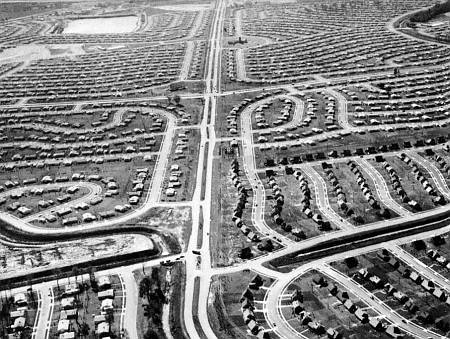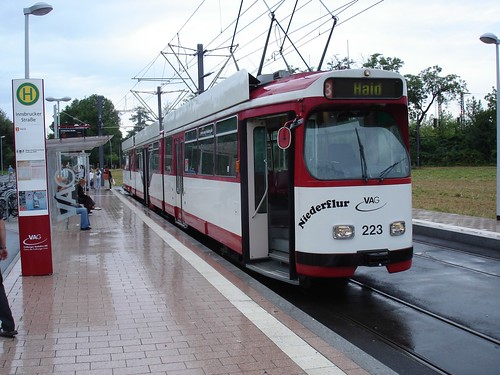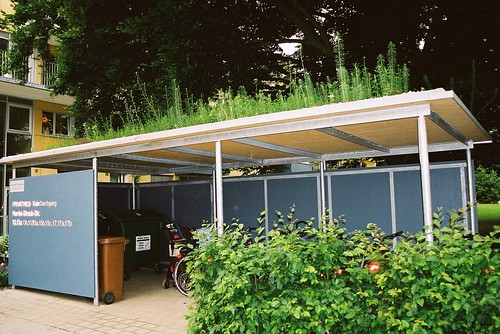An article in the New York Times yesterday gives some credence to the idea of viable car-free suburbs. This of course is the type of development people tend to look askance at even the suggestion of. According to our conventional history, after all, the explosion of the suburbs in the middle of the 20th century is closely tied to the popular availability of the automobile. The very idea of the suburb is so closely tied in our minds to famous car-based developments such as Levittown that the notion of a car-free suburb seems, well, self-contradictory.

Levittown, NewYork, the image of the suburb (thanks to riowight)
The community of Vauban, outside of Freiburg in Germany proves otherwise.

Vauban, Freiburg,Germany, a new sort of suburb (thanks to mattwyn)
Built on the site of a former German (and then French) military base, this suburban development, apparently completed in 2001, is a mixed-use community (pop: 5000, employed: 600) oriented towards pedestrians and ‘alternative’ means of transport such as bicycles and mass-transit. The cars, for people have not entirely given them up, are kept in large parking structures on the outskirts, but as of 2009 (according to Wikipedia), 70% of the residents had in fact given up their personal cars entirely. Transit into Freiburg is accommodated by a form of light rail, and residents also use car-sharing organizations.

Trolley station in Vauban (thanks to Kafeeinstein)
Because the community is laid out on the site of a former military base, never meant for navigation by private automobile, it seems to have something of a collegial feel to it – which you can only imagine would be strengthened by the slower and less alienating means of transit that its population has adopted. The layout also works well with the light rail system which runs through it, the layout accordingly elongated along the tracks so as to minimize the distance between any unit and the train.
At any rate, the development seems like a great precedent for communities of the future (the Times article reports on a similar project planned for California). Eliminating cars from neighbourhoods like this one not only makes them more sustainable but also makes them far more livable.

A bicycle garage in Vauban (thanks to adeupa de Brest)


10 comments
There’s absolutely nothing silly or out of the ordinary about car-free suburbs. Any Planning Theory/History class will illustrate how the first true suburbs were all built around trams/trolleys/streetcars, not the automobile.
The shift didn’t happen until Ford and Goodyear bought up all the tram companies and replaced them with buses.
Guess history really does repeat itself after all.
True enough – thanks A. It is good to remember that.
A: As unfortunate as the disappearance of streetcars from most major cities was, there was no vast conspiracy to replace them with buses at the hands of Detroit, that’s a myth. In reality, streetcars become financially unsupportable compared with buses for most cities, and were seen as archaic holdovers from the past after the Second World War. While GM and Ford did buy the occasional line through subsidiaries, the vast majority were simply torn up for the more economical buses.
That out of the way, interesting post. It’s good to see that new developments can be made without relying on the car.
The GM Streetcar Conspiracy is right up there with the grassy knoll in terms of never-ending conspiracy theories that may or may not be true (see http://en.wikipedia.org/wiki/General_Motors_streetcar_conspiracy for more) but I don’t think the original streetcar suburbs like Lawrence Park were ever entirely car-free. The streetcar was simply the way to get to work, a function that was later replaced by expressways. Garden suburbs had pretty segregated uses and, I think, never included on site employment or much shopping.
What the post really alludes to by “collegial” is the environment of that particular entity known as the American [Residential] College Campus w/ Adjoining College Town. (Most Canadian university campuses are rather different and not the right parallel.) Having lived for four years on such a campus with a very similar configuration to Vauban – one parking lot at the edge, local transit up the middle, lots of bikes, walkable shopping for all needs, commuter train connection to larger cities – I can say that the concept certainly is feasible. Trips off campus were very rare – maybe once every few months, especially by car, even though a good number of students had cars. I even had a car myself one summer but used it only every couple weeks for shopping…
If they ever close CFB Borden near always-growing Barrie (which has a GO station within trolley distance) it would be an interesting place to test the theory.
Is it just me, or does the tram above look a lot like an ALRV?
There’s a suburb sort of like this in Ontario. It’s called Vaughan.
Hi, Luke, am I reading your post right? Vaughan, car-free? Or did you mean Vaughan is sort of like Levittown (Which is probably true)?
I read this article when it was first pusblished, and the comments are stunning. Gotta love the lady who tried carsharing in the late 90s and decided her experience literally a decade ago is a solid rebuttal to my suggestion that people could join a carsharing program. I’m kind of flabbergasted how people really cannot let go of car ownership.
This is a very interesting article. I must say, Vauban does remind me of my U.S. college campus with one parking lot in the far corner of the campus. I miss those days when I drove so little that I would have to start my car and take it for a spin every two weeks or so just to make sure it started.
I work for vivaNext, where we are planning, designing and building the expansion of the rapid transit system in York Region. When you look at the Region from an aerial view, it looks a lot like the photo of Levittown. But we are working on improving transit options for York Region’s residents while laying the groundwork for transit-oriented developments. The goal is to provide people living in York Region a real choice when making their travel decisions so that they don’t need to own a car. We are building the system that will let them get everywhere they need to go by transit.
The idea of a car-centric suburb may not last much longer as people strive to spend less time in their car stuck in traffic and more time doing the things they enjoy.
What and where is York Region? I suspect it is Toronto, Canada, but I am not sure, because http://www.york.ca
does not seem to mention any larger city I am familiar with.